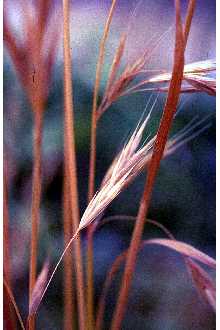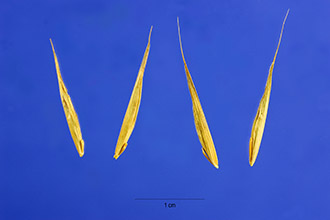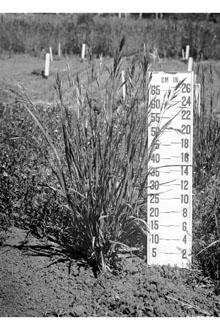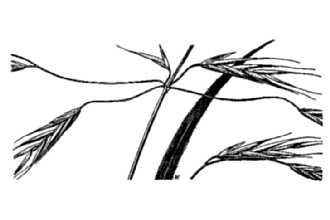Bromus carinatus Hook. & Arn. var. californicus (Nutt. ex Buckley) Shear
Scientific Name: Bromus carinatus Hook. & Arn. var. californicus (Nutt. ex Buckley) Shear
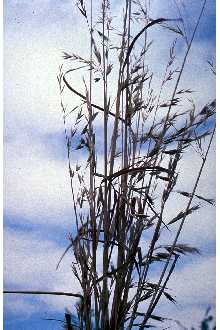
| General Information | |
|---|---|
| Usda Symbol | BRCAC2 |
| Group | Monocot |
| Life Cycle | AnnualPerennial, |
| Growth Habits | Graminoid |
| Native Locations | BRCAC2 |
Plant Guide
Alternate Names
Big brome, Bromus carinatus var. californicus, Bromus carinatus var. hookerianus, Bromus laciniatus, Ceratochloa carinata, keeled brome, mountain brome.
Uses
Ethnobotanic: The seeds of California brome were feared by the Native Americans to be poisonous if swallowed. However, they were often dried and ground into flour to make bread and other foods. Livestock: California brome is an important forage species for livestock throughout its growing season. It is sometimes planted as pasture grass. Restoration: California brome is a rapid establisher and has good soil stabilizing capabilities. For these reasons, it is useful for revegetation and erosion control in disturbed rangeland sites, spent oil shale, coalmine spoils, heavy metal mine tailings, and roadsides. It is best suited for side-slopes and back-slopes because it can withstand periodic drought. It is effective in improving water infiltration and has been used successfully on waterfront sites. Wildlife: Elk, grizzly bear, geese, squirrels, pocket gophers, and other rodents consume California brome plants. Birds consume the seeds. California brome also provides good cover for small mammals, small non-game birds, and upland game birds.
Status
Please consult the PLANTS Web site and your State Department of Natural Resources for this plant’s current status (e.g. threatened or endangered species, state noxious status, and wetland indicator values).
Weediness
The Western Society of Weed Science has listed California brome as having invasive characteristics. This plant may become weedy or invasive in some regions or habitats and may displace desirable vegetation if not properly managed. Please consult with your local NRCS Field Office, Cooperative Extension Service office, or state natural resource or agriculture department regarding its status and use. Weed information is also available from the PLANTS Web site at plants.usda.gov.
Description
General: Grass Family (Poaceae). California brome is a native, cool-season perennial bunchgrass that lives 3 to 5 years and grows to be 60 to 120 cm tall. The roots of California brome are fibrous, grow very quickly, and become deep and widespread. Young plants are erect, but older stems grow along the ground with only the apical tips remaining erect (decumbent). Stems are robust with hairy sheaths. Leaf blades are 0.5 to 1 cm wide and 15 to 30 cm long. They can be pubescent or glabrous. The inflorescence is a stiff, open panicle, 10 to 20 cm long and droops at maturity. The spikelets are 5 to 7 flowered, 2 to 4 cm long, 5 to 7 mm wide and flattened. Lemmas are 1 to 1.5 cm long, flattened, keeled and usually pubescent. The awns are 2 to 5 mm long. Seeds mature in May and June at low elevations and by late August at high elevations. Distribution: California brome occurs from Alaska east to Ontario and south to Illinois, Texas, California, and northern Mexico. It is native from the Pacific Coast to the Rocky Mountains and is casually introduced in the Great Plains. For current distribution, please consult the Plant Profile page for this species on the PLANTS Web site (http://plants.usda.gov). Habitat: California brome grows in open woods and forests, shrublands, grasslands, meadows, and waste places. It is closely associated with pine dropseed, bracken fern, corn lily, dwarf purple monkey flower, mountain muhly, and Rocky Mountain iris and shares dominance in plant communities like coastal prairie and northern coastal scrub, sagebrush steppes, aspen, oak woodland, and Douglas-fir.
Adaptation
California brome grows well in a variety of soils including poorly drained types. It is most abundant in moderately moist, well-developed, deep, medium-textured soils. It tolerates soils in the pH range of 5.5 to 8.0. It occurs in bottomlands, mountain slopes, valleys, and ridge tops, up to elevations of 4,000 m. It requires nearly full to full sunlight.
Management
Although fair control of California brome by trifluralin and pronomaide has been documented, it does not respond to most herbicides. It is reduced by heavy grazing and favored in moderate to light grazing. Sheep are more likely to kill plants by trampling them rather than overgrazing. Cattle are more likely to overgraze than trample the plants. California brome is top-killed by fire, but appears to recover within a few years. It can sprout from surviving root crowns as early as the next growing season. Coverage of California brome is slightly reduced from pre-fire levels for several years after fire, then returns to pre-fire levels. It is sometimes seeded in after fire to help stabilize soil.
Pests and Potential Problems
California brome is sometimes prone to stem rust, head smut, leaf rust, and leaf spot.
Seeds and Plant Production
Plant Production , Use soil moisture sensors to measure the soil moisture of Bromus carinatus Hook. & Arn. var. californicus (Nutt. ex Buckley) Shear.
Plant Production
Seeds are collected between May 1 and September 10, depending on rate of maturation. Mature inflorescences turn from green-purple to brown and mature seeds are light brown-gray. Cleaning is not required for germination. Seeds should be stored in a dry, evenly temperate environment. Dry refrigeration is best for long term storage. Seeds are surface sown, 3 seeds per container, and planted 2 times the diameter of seed to depth. Sixty-five percent germination will occur within 30 days and seedlings are transplanted into individual containers. Other sources state that 85% germination will occur in 13 days at 30oC, 83% in 13 days between 19o and 23oC, and 46% in 21 days at 14oC. Natural seed stock will have higher germination rates than commercial stock. Cultivars, Improved, and Selected Materials (and area of origin) California brome seed is readily available from commercial sources. ‘Southern Cal 1000’ Germplasm California brome (Bromus carinatus) was collected in 2006 in Orange County near Irvine Ranch at 1,000 feet elevation on silty clay soils in a purple needlegrass community. It was selected from 28 accessions after a two-year field trial evaluation. It is noted for its vigor, plant mass, and seed yield amongst other southern California accessions within the trial. It is recommended for use in southern California in MLRA 14d, 15d, 19 and 20. ‘Central Coast 2600’ Germplasm California brome (Bromus carinatus) was collected in 2006 in a location east of Los Olivos, California on Figueroa Mountain at 2,600 feet elevation on sandy clay soils in a blue oak grassland community. It was selected from 28 accessions after a two-year field trial evaluation. It is noted for its superior vigor, height, and seed yield. It is recommended for use in MLRA 15d, 20, 22d, and 22e. ‘Coastal 500’ Germplasm California brome (Bromus carinatus) was collected in 2006 in San Luis Obispo County near Cal Poly Canyon at 500 feet elevation on sandy clay loam soils in a coast live oak grassland community. It was selected from 28 accessions after a two-year field trial evaluation. It is noted for its vigor, plant mass, and seed yield. It is recommended for use in MLRA 4c, 14c, 14d, 15c, and 15d. ‘Northern Cal 40’ Germplasm California brome (Bromus carinatus) was collected in 2006 near Point Pinole in Pinole, California at 40 feet elevation on silty clay loam soils within an annual grassland community. It was selected from 28 accessions after a two-year field trial evaluation. It is noted for its superior vigor, plant mass, early seed production, and seed yield amongst other coastal accessions within the trial. It is recommended for use in MLRA 14c, 14d, 15c, 15d, 15e, 16e, 17d, 17e, and 18d. ‘Central Sierra 3200’ Germplasm California brome (Bromus carinatus) was collected in 2006 in Yuba County at Pike County Peak at 3,200 feet elevation on silty clay soils within a pine and fir community. It was selected from 28 accessions after a two-year field trial evaluation. It is noted for its superior vigor, plant mass, and seed yield amongst other higher elevation accessions within the trial. It is recommended for use in MLRA 18d, 22c, and 22d. ‘Bromar’ is recommended for revegetating high-elevation sites. It is resistant to stem rust, head smut, leaf rust, and leaf spot. ‘Cucamonga’ is recommended for erosion control and ground cover on droughty, low fertility grasslands. It can also be used for revegetation of disturbed areas, and wildfire land rehabilitation It is susceptible to head smut, which can be controlled with a mercuric fungicide. This cultivar was collected from a native stand near Cucamonga, California in 1939. ‘Luval’ is a drought resistant cultivar.
Control
Please contact your local agricultural extension specialist or county weed specialist to learn what works best in your area and how to use it safely. Always read label and safety instructions for each control method. Trade names and control measures appear in this document only to provide specific information. USDA NRCS does not guarantee or warranty the products and control methods named, and other products may be equally effective.
References
Agricultural Research Center. 2004. GRIN taxonomy (http://www.ars-grin.gov/cgi-bin/npgs/html/index, 2 July 2004). USDA, Beltsville. Harrison, S. 2000. Rangeland ecosystems and plants (http://www.usask.ca/agriculture/plantsci/classes/range/index.html, 2 July 2004). University of Saskatchewan, Saskatoon. Howard, J.L. 1997. Bromus carinatus. (http://www.fs.fed.us/database/feis/, 2 July 2004). Rocky Mountain Research Station, USDA Forest Service, Missoula. Moerman, D. 2003. Native American ethnobotany database (http://herb.umd.umich.edu, 2 July 2004). University of Michigan, Dearborn. Pratt, M., J. Bowns, R. Banner, and A. Rasmussen. 2002. Range plants of Utah (http://extension.usu.edu/rangeplants/index.htm, 2 July 2004). Utah State University Extension, Logan. Wilson, M. 2004. Bromus carinatus (http://oregonstate.edu/~wilsomar/Species/Brca.htm, 2 August 2004). Department of Botany and Plant Pathology, Oregon State University, Corvallis. Young, B. 2001. Propagation protocol for production of container Bromus carinatus Hook. & Arn. Plants. (http://www.native plantnetwork.org, 2 July 2004). College of Natural Resources, University of Idaho, Moscow. Prepared By: Sarah Wennerberg, previously USDA NRCS National Plant Data Center, Baton Rouge, Louisiana Species Coordinator: Mark Skinner, USDA NRCS National Plant Data Center, Baton Rouge, Louisiana Edited: 4Aug2004 sbw; 21Oct2004 rln; 27sep05 jsp; 25may06jsp; 01July08capmc; 080916jsp For more information about this and other plants, please contact your local NRCS field office or Conservation District, and visit the PLANTS Web site<http://plants.usda.gov> or the Plant Materials Program Web site <http://Plant-Materials.nrcs.usda.gov> The U.S. Department of Agriculture (USDA) prohibits discrimination in all its programs and activities on the basis of race, color, national origin, sex, religion, age, disability, political beliefs, sexual orientation, and marital or family status. (Not all prohibited bases apply to all programs.) Persons with disabilities who require alternative means for communication of program information (Braille, large print, audiotape, etc.) should contact USDA's TARGET Center at 202-720-2600 (voice and TDD). To file a complaint of discrimination write USDA, Director, Office of Civil Rights, Room 326-W, Whitten Building, 14th and Independence Avenue, SW, Washington, DC 20250-9410 or call 202-720-5964 (voice or TDD). USDA is an equal opportunity provider and employer. Read about Civil Rights at the Natural Resources
Plant Traits
Growth Requirements
| CaCO3 Tolerance | Medium |
|---|---|
| Frost Free Days, Minimum | 150 |
| Frost Free Days, Minimum | 140 |
| Fire Tolerance | None |
| Fire Tolerance | Low |
| Fertility Requirement | Medium |
| Fertility Requirement | Low |
| Drought Tolerance | Medium |
| Drought Tolerance | Low |
| Cold Stratification Required | No |
| Cold Stratification Required | No |
| Temperature, Minimum (°F) | 2 |
| CaCO3 Tolerance | Low |
| Anaerobic Tolerance | None |
| Anaerobic Tolerance | None |
| Adapted to Medium Textured Soils | Yes |
| Adapted to Medium Textured Soils | Yes |
| Adapted to Fine Textured Soils | No |
| Adapted to Fine Textured Soils | No |
| Adapted to Coarse Textured Soils | Yes |
| Adapted to Coarse Textured Soils | Yes |
| Hedge Tolerance | None |
| Temperature, Minimum (°F) | 17 |
| Shade Tolerance | Intolerant |
| Shade Tolerance | Intolerant |
| Salinity Tolerance | Medium |
| Salinity Tolerance | Medium |
| Root Depth, Minimum (inches) | 8 |
| Root Depth, Minimum (inches) | 8 |
| Precipitation, Minimum | 8 |
| Precipitation, Minimum | 14 |
| Precipitation, Maximum | 20 |
| Precipitation, Maximum | 20 |
| pH, Minimum | 6.0 |
| pH, Minimum | 5.5 |
| pH, Maximum | 8.0 |
| pH, Maximum | 8.0 |
| Moisture Use | Medium |
| Moisture Use | Low |
| Hedge Tolerance | None |
Morphology/Physiology
| Active Growth Period | Spring and Summer |
|---|---|
| Toxicity | None |
| Toxicity | None |
| Shape and Orientation | Erect |
| Shape and Orientation | Erect |
| Resprout Ability | No |
| Fall Conspicuous | No |
| Foliage Porosity Winter | Porous |
| Foliage Porosity Summer | Moderate |
| Foliage Porosity Summer | Dense |
| Foliage Color | Green |
| Foliage Color | Green |
| Flower Conspicuous | No |
| Flower Conspicuous | No |
| Flower Color | Yellow |
| Flower Color | Yellow |
| Fire Resistant | No |
| Fire Resistant | No |
| Nitrogen Fixation | None |
| Fall Conspicuous | No |
| Coppice Potential | No |
| Coppice Potential | No |
| C:N Ratio | Low |
| C:N Ratio | High |
| Bloat | None |
| Bloat | Low |
| After Harvest Regrowth Rate | Moderate |
| Active Growth Period | Fall, Winter and Spring |
| Resprout Ability | No |
| Foliage Texture | Coarse |
| Nitrogen Fixation | None |
| Low Growing Grass | No |
| Low Growing Grass | No |
| Lifespan | Short |
| Lifespan | Short |
| Leaf Retention | No |
| Leaf Retention | No |
| Known Allelopath | No |
| Known Allelopath | No |
| Height, Mature (feet) | 4.0 |
| Growth Rate | Rapid |
| Height, Mature (feet) | 2.5 |
| Foliage Porosity Winter | Porous |
| Foliage Texture | Coarse |
| Fruit/Seed Color | Brown |
| Fruit/Seed Color | Brown |
| Fruit/Seed Conspicuous | No |
| Fruit/Seed Conspicuous | No |
| Growth Form | Bunch |
| Growth Form | Bunch |
| Growth Rate | Rapid |
Reproduction
| Propagated by Cuttings | No |
|---|---|
| Propagated by Seed | Yes |
| Propagated by Seed | Yes |
| Propagated by Sod | No |
| Propagated by Sod | No |
| Propagated by Sprigs | No |
| Propagated by Sprigs | No |
| Propagated by Tubers | No |
| Propagated by Tubers | No |
| Fruit/Seed Persistence | No |
| Seed per Pound | 106680 |
| Seed per Pound | 106680 |
| Seed Spread Rate | Moderate |
| Seed Spread Rate | Rapid |
| Seedling Vigor | High |
| Seedling Vigor | High |
| Small Grain | No |
| Small Grain | No |
| Vegetative Spread Rate | None |
| Vegetative Spread Rate | None |
| Propagated by Corm | No |
| Propagated by Cuttings | No |
| Bloom Period | Early Spring |
| Bloom Period | Spring |
| Commercial Availability | Routinely Available |
| Commercial Availability | Routinely Available |
| Fruit/Seed Abundance | High |
| Fruit/Seed Abundance | High |
| Fruit/Seed Period Begin | Spring |
| Fruit/Seed Period Begin | Spring |
| Fruit/Seed Period End | Spring |
| Fruit/Seed Persistence | No |
| Propagated by Bare Root | No |
| Propagated by Bare Root | No |
| Propagated by Bulb | No |
| Propagated by Bulb | No |
| Propagated by Container | No |
| Propagated by Container | No |
| Propagated by Corm | No |
| Fruit/Seed Period End | Summer |
Suitability/Use
| Palatable Browse Animal | High |
|---|---|
| Palatable Graze Animal | High |
| Palatable Graze Animal | High |
| Palatable Human | No |
| Palatable Human | No |
| Post Product | No |
| Post Product | No |
| Protein Potential | Medium |
| Protein Potential | Medium |
| Pulpwood Product | No |
| Pulpwood Product | No |
| Veneer Product | No |
| Veneer Product | No |
| Palatable Browse Animal | High |
| Nursery Stock Product | No |
| Nursery Stock Product | No |
| Naval Store Product | No |
| Naval Store Product | No |
| Lumber Product | No |
| Lumber Product | No |
| Fodder Product | Yes |
| Fodder Product | Yes |
| Christmas Tree Product | No |
| Christmas Tree Product | No |
| Berry/Nut/Seed Product | No |
| Berry/Nut/Seed Product | No |

